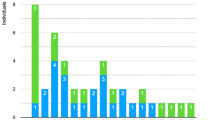Abstract
Introduction
There are no reliable noninvasive methods of monitoring ICP. Most assessments are made by indirect measures and are difficult to follow over time. Invasive studies can be used but up until now have required in-hospital transcutaneous measurements. Accurate ICP recordings over longer periods of time can be very valuable in timing different surgical procedures in syndromal cases. This case shows that telemetric ICP monitoring can be used for long-term follow-up in patients that may need repeated surgeries related to their craniosynostosis condition.
Case report
In this report, the telemetric ICP probe (Raumedic Neurovent-P-tel) was implanted before surgery and was used for repeated “noninvasive” ICP recordings pre- and postoperatively in a patient with craniosynostosis. The patient was an eight-year-old girl with pansynostosis with only the right lambdoid suture open. A telemetric ICP probe was implanted the day before cranial vault remodeling and the ICP was monitored pre- and postoperatively. The ICP was above 15 mmHg 72.2 % of the monitoring time before surgery, and the amplitude of the curve was greater than normal suggesting impaired compliance. Direct postoperative ICP was normal, and the amplitude was lower. The ICP was then monitored both in out-patient clinic and in four longer hospital stays. Both the values and the curves were analyzed, and the time with ICP above 15 mmHg decreased over time, and the waveform amplitude of the curves improved.
Conclusion
This “noninvasive” way of recording ICP is a feasible and helpful tool in decision-making and intervening in patients with craniosynostosis.



Similar content being viewed by others
References
Antes S, Tschan C, Kunze G, Ewert L, Zimmer A, Halfmann A, Oertel J (2014) Clinical and radiological findings in long-term intracranial pressure monitoring. Acta Neurochir 156:1009–1019
Kiefer M, Antes S, Leonhardt S, Schmitt M, Orakcioglu B, Sakowitz OW, Eymann R (2012) Telemetric ICP measurement with the first CE-approved device: data from animal experiments and initial clinical experiences. In: Schuhmann M, Czosnyka M (eds) Intracranial Pressure and Brainmonitoring XIV. Springer, Wien, pp 111–116
Lilja A, Andresen M, Hadi A, Christoffersen D, Juhler M (2014) Clinical experience with telemetric intracranial pressure monitoring in a Danish neurosurgical center. Clin Neurol Neurosurg 120:36–40
Lundberg N, Troupp H, Lorin H (1965) Continuous recording of the ventricular-fluid pressure in patients with severe acute traumatic brain injury. A preliminary report. J Neurosurg 6:581–90
Gault D, Renier D, Marchac D, Jones B (1992) Intracranial pressure and intracranial volume in children with Craniosynostosis. Plast Reconstr Surg 90:377–381
Renier D, Sainte-Rose C, Marchac D, Hirsch J-F (1982) Intracranial pressure in craniostenosis. J Neurosurg 57:370–377
Thompson D, Harkness W, Jones B, Gonsalez S, Andar U, Hayward R (1995) Subdural intracranial pressure monitoring in craniosynostosis: its role in surgical management. Childs Nerv Syst 11:269–275
Wall S, Thomas G, Johnson D, Byren J, Jayamohan J, Magdum S, McAuley D, Richards P (2014) The preoperative incidence of raised intracranial pressure in nonsyndromic sagittal craniosynostosis is underestimated in the literature. J Neurosurg Pediatr 16:674–681
Gault D, Renier D, Marchac D, Ackland F, Jones B (1990) Intracranial volume in children with craniosynostosis. J Craniofac Surg 1:1–3
McCarthy J, Glasberg S, Cutting C, Epstein F, Grayson B, Ruff G, Thorne C, Wisoff J, Zide B (1995) Twenty-year experience with early surgery for craniosynostosis II. The craniofacial synostosis syndromes and pansynostosis—results and unsolved problems. Plast Reconstr Surg 96:284–295
Siddiq S, Posnick J, Buncic R, Humphreys R, Hoffman H, Drake J, Rutka J (1995) The detection and management of intracranial hypertension after initial suture release and decompression for craniofacial dysostosis syndromes. Neurosurgery 36:703–709
Wall S, Goldin J, Hockley H, Wake M, Poole M, Briggs M (1994) Fronto-orbital re-operation in craniosynostosis. Br J Plastic Surg 47:180–184
Adamo M, Pollack I (2010) A single-center experience with symptomatic postoperative calvarial growth restriction after extended strip craniectomy for sagittal craniosynostosis. J Neurosurg Pediatr 5:131–135
Cetas J, Nasseri M, Saedi T, Kuang A, Selden N (2013) Delayed intracranial hypertension after cranial vault remodeling for nonsyndromic single-suture synostosis. J Neurosurg Pediatr 11:661–666
Foster K, Frim D, McKinnon M (2008) Recurrence of synostosis following surgical repair of craniosynostosis. Plast Reconstr Surg 12:70–76
Hudgins R, Cohen S, Burstein F, Boydston W (1998) Multiple suture synostosis and increased intracranial pressure following repair of single suture, nonsyndromal craniosynostosis. Cleft Palate Craniofac J 35:167–72
Thomas G, Johnson D, Byren J, Judge A, Jayamohan J, Magdum S, Richards P, Wall S (2015) The incidence of raised intracranial pressure in nonsyndromic sagittal craniosynostosis following primary surgery. J Neurosurg Pediatr 15:350–360
Tamburrini G, Caldarelli M, Massimi L, Gasparini G, Pelo S, Di Rocco C (2012) Complex craniosynostoses: a review of the prominent clinical features and the related management strategies. Child’s Nerv Syst 28:1511–1523
Author information
Authors and Affiliations
Corresponding author
Rights and permissions
About this article
Cite this article
Magnéli, S., Howells, T., Saiepour, D. et al. Telemetric intracranial pressure monitoring: a noninvasive method to follow up children with complex craniosynostoses. A case report. Childs Nerv Syst 32, 1311–1315 (2016). https://doi.org/10.1007/s00381-016-3023-4
Received:
Accepted:
Published:
Issue Date:
DOI: https://doi.org/10.1007/s00381-016-3023-4




